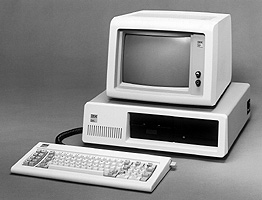-
 Architecture/design shoot outs
Architecture/design shoot outs
In this brand-new series I will compare different CPUs at the same operating speed, thereby showing -I hope- that design is sometimes more important than mere MHz.
Let's start at the beginning then.
Nowadays John Public seems to think that computers ought to have a x86 CPU, especially after Apple changed from the Power archtecture to x86. x86, for all its present market dominance, had a bit of a shaky start though. The Intel 8086, the first Intel 16-bit CPU, was the first true x86 CPU. It was designed beween 1976 and 1978, when it was brought out to the consumer market. By sheer coincidence this was when I left highschool. In its best version made by Intel it reached a whopping 10 MHz.
To enchance its performance a co-processor could be sticked in the motherboard, the Intel 8087. This FPU had to run at the same speed as the CPU and could perform at around 30,000 to 50,000 FLOPS (Floating Point Operations per Second).
There was also a cheaper and less complicated version with a only 8 Mhz external data bus, the Intel 8088, that also could be supported by the 8087, but needed less supporting -and cheaper- ICs. It was this CPU that paved the way for the -then- future x86 archticture, as IBM decided to use it -the 8088- in their first, now classic, IBM-PCs: 
Socket-wise, DIP-40 ruled these days.
Motherboards in these days were huge, the Intel 8086 was to be supported by these:
- Intel 8237: direct memory access (DMA) controller
- Intel 8251: USART
- Intel 8253: programmable interval timer
- Intel 8255: programmable peripheral interface
- Intel 8259: programmable interrupt controller
- Intel 8279: keyboard/display controller
- Intel 8282/8283: 8-bit latch
- Intel 8284: clock generator
- Intel 8286/8287: bidirectional 8-bit driver
- Intel 8288: bus controller
- Intel 8289: bus arbiter
The 8086, 8088 and 8087 chips were made by Intel, AMD (AMD 8086 on CPU-World; AMD 8088 on CPU-World; AMD 8087 on CPU-World), NEC, Fujitsu, Harris (Intersil), OKI, Siemens, Texas Instruments, Mitsubishi and Panasonic (Matsushita), to name but a few.
They had to compete with CPUs like the Motorola 6800, the Motorola 6809, the MOS Technology 6502 and the Zilog Z80.
I found these MIPS values -as used in BOINC- for them:
| CPU |
Design |
Market |
Internal
Databus |
External
Databus |
Operating speed
in MHz |
DMIPS/
MHz |
Dhrystone
MIPS |
NPU/FPU |
|---|
| MOS Technology 6502 |
1974 |
1975 |
8-bit |
8-bit |
1-4 |
0.43 |
0.43-1.72 |
none |
| Zilog Z-80 |
1974 |
1976 |
8-bit |
8-bit |
2.5-20 |
0.145 |
0.36-2.90 |
AMD9511 |
| Kawasaki KL5C8400C |
197? |
197? |
8-bit |
8-bit |
33 |
0.165 |
5.7 |
AMD9511 |
| Motorola 6809 |
1974 |
1978 |
8-bit |
8-bit |
1-2 |
0.42 |
0.42-0.84 |
none |
| Intel 8086 |
1976 |
1978 |
16-bit |
16-bit |
5-10 |
0.066 |
0.33-0.66 |
8087 |
| Intel 8088 |
1976 |
1979 |
16-bit |
8-bit |
5-10 |
0.075 |
0.37-0.75 |
8087 |
| NEC V20 |
198? |
1982 |
16-bit |
8-bit |
8-16 |
0.5 |
4-8 |
8087 |
| NEC V30 |
198? |
1983 |
16-bit |
16-bit |
8-16 |
0.5 |
4-8 |
8087 |
And interesting, as I would always choose the fully 16-bit 8086 above the hybrid 8/16-bit 8088. By watching the internal databus we can also observe a distinct 'watershed' between the last of the 8-bit CPUs and the first of the 16-bit CPUs. But... these are the true dinosaurs of computing, and BOINC-wise of no use.
The winner (cpu-class):  The NEC V30. The winner (fpu-class):
The NEC V30. The winner (fpu-class):  The 10 MHz Intel D8087-1.
The 10 MHz Intel D8087-1.
OS-wise there is the interesting fact that IBM PC-DOS 1.0 (that came with the IBM PC) and MS-DOS 1.0 (that you had to buy when you bought or built a clone) never ran on less than a 16-bit 8088, while the original CP/M (which had inspired the early DOS developers) already ran on a 8-bit Z-80. Later CP/M versions included a CP/M-86 for the 8086, the original CP/M by that time having been renamed to CP/M-80.
To be continued.
Last edited by Dirk Broer; 06-04-2015 at 08:14 PM.
Tags for this Thread
 Posting Permissions
Posting Permissions
- You may not post new threads
- You may not post replies
- You may not post attachments
- You may not edit your posts
-
Forum Rules

The NEC V30. The winner (fpu-class):
The 10 MHz Intel D8087-1.









 Reply With Quote
Reply With Quote
